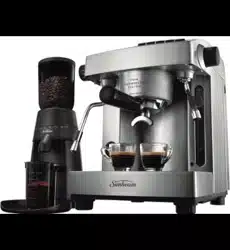Loading ...
Loading ...
Loading ...

Heading
25
Guide to milk texturing
Milk texturing is the steaming of milk. The
steam does two things, heats the milk and
also the steam mixes air with the milk to
form an ‘emulsion’ of tiny bubbles that gives
a silky velvet texture. Similar to making an
espresso, perfecting the art of milk texturing
takes time and practice.
Tip: Remember espresso is the foundation for
all espresso-coffee drinks and the milk is the
variable.
1. Determine how much milk is needed
based on the number of cups being made
or the size of the texturing jug.
Tip: Keep in mind that the volume of milk
will increase or ’stretch’ during the texturing.
2. Pour cold refrigerated milk into a
stainless steel jug, between
to ²/
³
full.
Tip: Best results will be achieved by using a
clean jug and cold, fresh milk.
3. Purge the steam wand of any water.
With the steam wand positioned over the
drip tray activate the steam function by
turning the steam control dial clockwise
as far as it will go (35). Once any water
has been purged close the steam by
turning the steam control dial anti-
clockwise (36).
4. Swing the steam wand to the side of the
espresso machine (37).
5. Place the steam wand into the milk
so that the tip of the steam nozzle is
just below the surface of the milk and
activate the steam function by turning
the steam control dial clockwise as far as
it will go (38).
6. Angle the jug so that the steam wand is
resting on the spout of the jug and lower
the jug until the tip of the steam nozzle
is just below the surface of the milk. This
will start to create a whirlpool action in
the milk (39).
Note: How we introduce the air to the milk
will determine the consistency of the foam.
If we catch large gulps of air the quality of
the foam will reflect this by having large
bubbles. If we can introduce air to the milk
in a controlled gentle fashion indicated by a
gentle hissing sound the milk will have a fine
aerated bead in the textured foam.
7. As the steam heats and textures the milk,
the level of the milk in the jug will begin
to rise. As this happens follow the level
of the milk by lowering the jug, always
keeping the tip of the steam nozzle just
below the surface. This will create a
slight hissing noise.
Tip: The amount of foam required will vary
depending on the drinks being made, for
example a cappuccino requires more foam
than a flat white.
8. Close the steam immediately when the
milk is heated to between 60-65°C
by turning the steam control dial anti-
clockwise (40).
Tip: The optimum drinking temperature of
milk is between 60-65°C and we advise
you use a milk thermometer to achieve
the correct temperature. It's important to
remember that if the milk is not heated long
enough the drink will be too cool and if the
milk is heated for too long it will start to boil
at around 72°C and all texture will be lost.
Tip: If you don’t have a thermometer a good
indication that the correct temperature has
been reached is when the jug becomes too
hot to leave your fingers in contact.
Important: Do not boil the milk as the texture
and taste will be affected.
9. Remove the jug and wipe the steam nozzle
and wand with a clean damp cloth (41).
10. With the jug in hand tap the jug on the
bench top to release the trapped air
bubbles. Agitate the milk as this helps
the milk and froth combine for an even
consistency.
Loading ...
Loading ...
Loading ...
